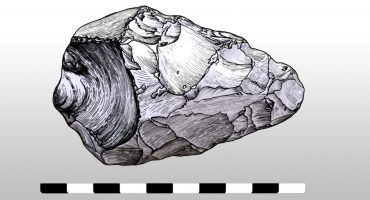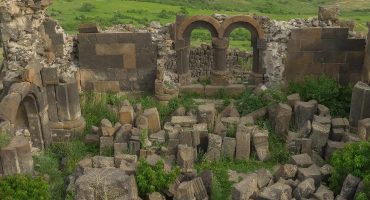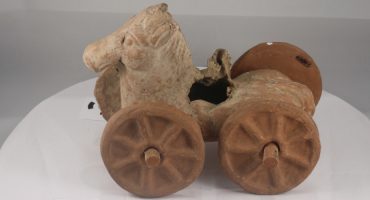About Us
We are Samantha Masters and Franziska Naether, a lecturer in Greek and Roman material culture and an Egyptologist. We are both from the Department of Ancient Studies at Stellenbosch University, in South Africa, where Franziska Naether is currently on leave from Leipzig University, Germany. Together, we teach a class on looking at ancient art and artefacts.
A part of this course was a brief introduction to museology and digital creation and the students were set a task to create 3D models from the Iziko collection in Cape Town, or from our own Department’s collection.
Franziska Naether: I became interested in 3D modelling during my sabbatical at the Institute of the Study of the Ancient World in New York. While there, I participated in a very advanced graduate seminar by Sebastian Heath covering a broad variety of topics in AR, VR, 3D and the whole wide world. I am particularly interested in digital curating and how museums can make use of new technologies to visualize artifacts and remains — especially photogrammetry — in order to make them available to the public and to draw more crowds into their buildings.
We know now that selfies, instagram posts, and 3D models shared on social media increase the number of visitors: the people want to see the real thing, and your 3D models can be an appetizer to entice crowds who might not have visited your institution yet. The fear that people will stay at home and look at a museum’s display solely through their phones on a couch is unfounded.
I’m an Egyptologist with great interest in the written and material culture of Egypt and the Graeco-Roman world but also in the reception of the classical world in modern periods. Currently, I am finishing a monograph on cult practices in Egyptian works of fiction. Another recent project is focussed on a digital representation and analysis of the Rosetta Stone in its three languages.
Dr. Masters: I am a lecturer in Ancient Studies specialising in Graeco-Roman material culture. My particular interest is in ancient Greek pottery and its iconography, but I am also interested in the reception of antiquity in the contemporary world. I have started exploring cases studies of contemporary artists’ use of classical motifs, themes and forms in their work, and I am also currently working on an extensive project related to the collections of antiquities in South Africa.
For a few decades most collections of antiquities in South African museums have been placed in storage and it has been my goal to not only study the collections but to make them accessible to a broad audience. I am also passionate about students and finding ways to improve their knowledge, skills and experience of the field in creative and non-traditional ways.
 Introduction to the objects by Dr. Masters and Esther Esmyol (right), Curator at Iziko Museums of South Africa in Cape Town. © Masters/Naether
Introduction to the objects by Dr. Masters and Esther Esmyol (right), Curator at Iziko Museums of South Africa in Cape Town. © Masters/NaetherFranziska Naether: 3D technology is quite a thing now on archaeological excavations to visualize whole structures such as temples or settlements – but also individual objects. Even restorations could be made through digital conservation. As a very recent example, see the reconstruction of the statue of the pharaoh Psamtik by my Egyptian and Leipzig colleagues in Cairo.
I started like most of the students: by trying to create models with easy tools such as phone cameras and objects in museums, at the Metropolitan Museum of Art in New York. I also tried to find out more about the legal framework and copyrights on the digital creations in the countries I’m working in – an often overlooked but nevertheless crucial aspect when it comes to long-term archiving of one’s work.
Dr. Masters: In order to preserve the data on the South African collections, and also to make them more accessible, the digitisation of the objects and their data is of course absolutely necessary and this process has already begun. The 3D modelling brings these objects, which may well not be seen in the museum case again for some time, to life in the 3-dimensional digital realm. These models will be showcased in “South Africa, Greece, Rome: a digital museum”, and be shared with Iziko as well. I am also pleased to involve the students in this project. 3D modeling of ancient artefacts combines the interests of the students very well: they are passionate about the ancient world and they are fascinated with technology.
How We Use 3D in our Work
My current approach is from a curator’s point of view: I’d like to digitize ancient artifacts to supplement special exhibitions. By doing this, visitors are enabled to interact with the museum before, during and after the show. They might discover more than what they see by looking at the showcases behind glass. For my latest exhibition on Graeco-Roman Egypt in Leipzig, the students and I created a couple of simple models by using phone cameras and Agisoft Photoscan. The 3D modelling is part of a seminar where I teach briefly on the historical backgrounds of the ancient cultures but also introduce them to the basic principles of creating exhibits, museum marketing, interacting with the press, writing texts for catalogues and audio guides, what is archaeogaming, etc. Therefore, we can only dedicate a few hours for first steps into photogrammetry. My experience shows that the 3D part is the most demanding and time-consuming section of a class, but also the most rewarding. No matter if it’s the US, Germany or South Africa – I have been very fortunate so far to have very devoted students who easily picked up on the technology.
Additionally, 3D is a great way to preserve cultural heritage for further generations and to digitize what museums have in storage. In this way, visitors can appreciate artifacts which might not be shown in exhibits. This contributes to long-term archiving. Since much of our research is tax-funded, I’m a great advocate for open access and open source technology as far as possible. Cultural heritage should not be hidden behind a paywall, and players should work together to share their materials and experiences.
Workflow and Equipment
This is my usual workflow:
- Establishing the terms and conditions (such as copyrights, sharing and archiving your data, collecting metadata of your objects) with the institution holding the artifacts
- Preparing the environment (such as surface, lights, conservation and security aspects while working in a museum environment)
- Taking pictures (and take all plugs, adaptors etc. with you); I have tried a couple of phone cameras but also SLR cameras including videographing but not yet 3D scanners
- Creating the models in Agisoft Photoscan
- Refining the models (e.g. with Meshlab, Meshmixer – depending upon what your purpose is)
- Uploading them on Sketchfab – and don’t forget a description
- Sharing them widely
Good light is essential! And the surface of the artifact itself and the one on which the object is standing – the software has issues with stitching together photos into a 3D model when the surface is too shiny or with a texture that’s hard to grasp or with only few colors. In this case, try to take many pictures and select only the really good ones for photogrammetry. Try also modelling different chunks and combining them for the final model.
Advice for Beginners
Go ahead and try it! Always try to think: If I were a computer that doesn’t know anything about Mycenaean vessels, Roman marble busts or Egyptian scarabs, where would I have trouble recognizing a form, a shape, a handle? And don’t use 500 photos for a model of a small object.
Looking Ahead
A lot of things have already been changed by museums who are very often on the forefront of using new technologies. It’s impressive to see what has already been accomplished by institutions such as the Metropolitan Museum or the British Museum – and by the field archaeologists. Archaeology is turning more and more into a digital discipline. Conservation trusts and universities must react to this development in teaching and funding. Long-term data archiving and providing business models for this, however, should be national endeavors. There is still a long way to go. Through digital technologies, we can also contribute to the decolonization of our disciplines.
A step in this direction is our brand new project, “South Africa, Greece, Rome: a digital museum”, where we have started collecting ancient artifacts but also objects and media of the reception of the Ancient World in South Africa. Our aim is to make this treasure trove available for all to see – and to study its implications. Much to do in the future!
 Excursion from Stellenbosch to the Iziko Social History Centre in Cape Town (Dr. Samantha Masters, Dr. Franziska Naether and students of Ancient Studies Stellenbosch and scholars and students from the University of Cape Town). © Masters/Naether
Excursion from Stellenbosch to the Iziko Social History Centre in Cape Town (Dr. Samantha Masters, Dr. Franziska Naether and students of Ancient Studies Stellenbosch and scholars and students from the University of Cape Town). © Masters/NaetherOur Favorite Historical Models on Sketchfab
Of course, my latest object of research, the Rosetta Stone from the British Museum:
But I’m also impressed with South African Rock Art digitized by the African Conservation Trust:




